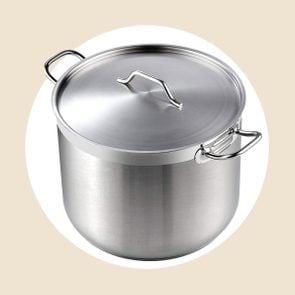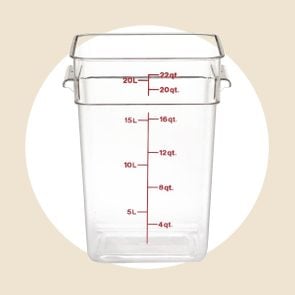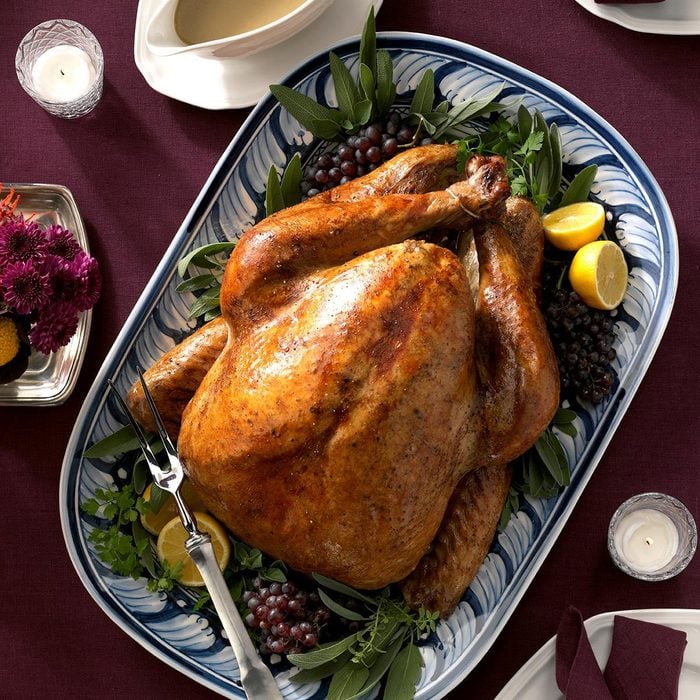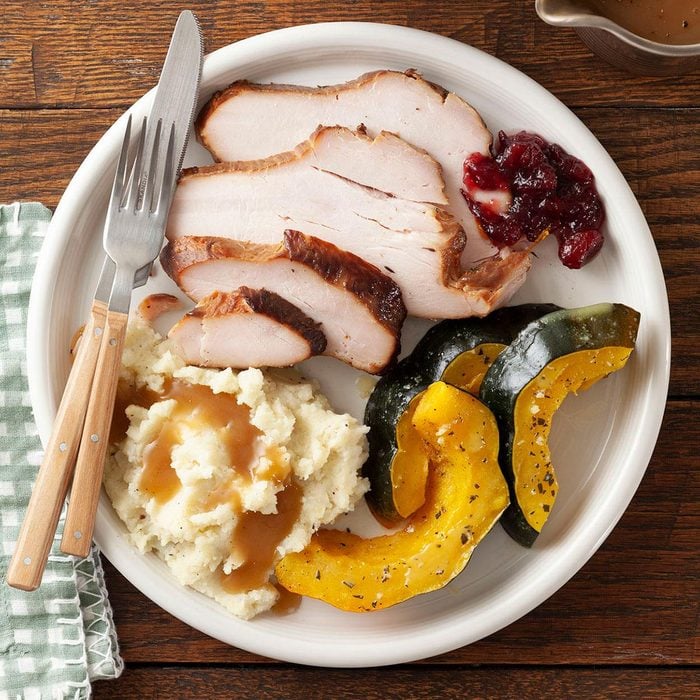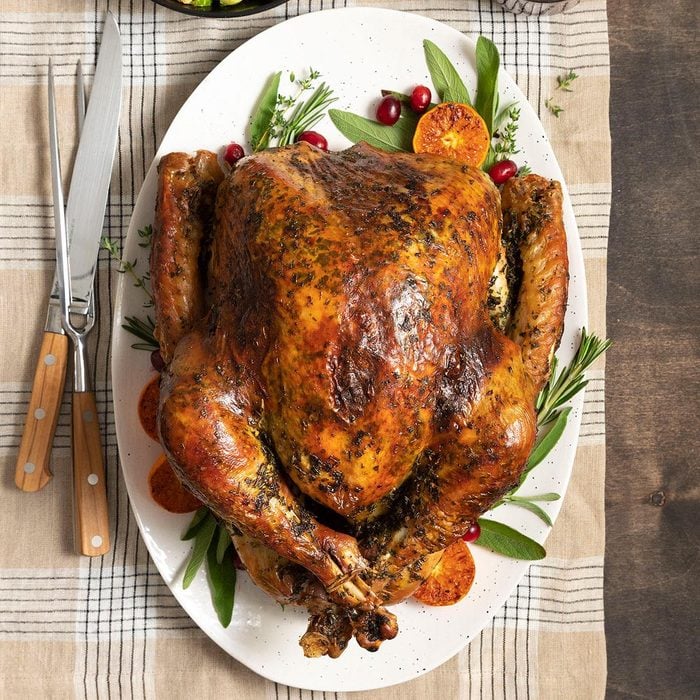How to Brine a Turkey
Updated: Apr. 13, 2024
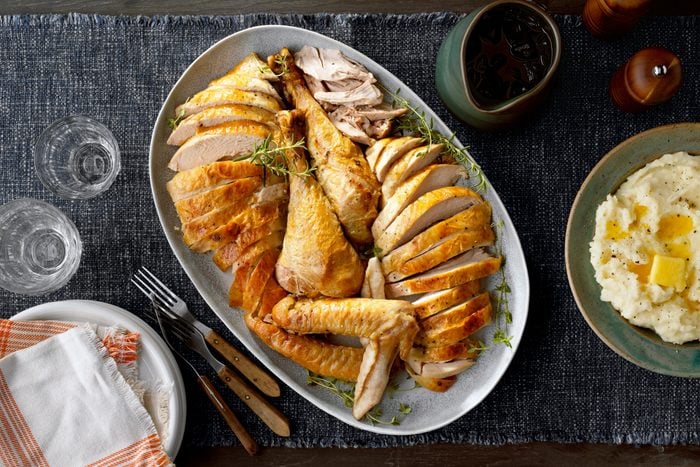
Put a stop to dry, flavorless birds. Learn how to brine a turkey using the traditional wet brine method.
Brining isn’t a topic that gets brought up most of the year. I rarely get messages from friends and family members wondering how to brine a pork loin or a whole chicken. But, as Thanksgiving draws nearer, the inquiries start flying, and they all have one ask: How do I season a turkey correctly, so that it doesn’t turn out dry and boring this year? The answer: Brine it.
On This Page
What is brining?
Brining uses salt to add flavor, tenderize and infuse meat with extra moisture. It can be done by submerging meat into a saltwater solution (a wet brine) or by sprinkling salt directly onto the meat (a dry brine). The salt denatures the meat’s proteins, causing the muscle fibers to unravel and swell. This allows the cells to retain more moisture than normal, trapping so much liquid inside that it can’t all evaporate during the cooking process.
Brining is the most foolproof way to add flavor— especially if you’re trying the spatchcock method this year. Basically, it builds in overcooking protection. As meat cooks, the muscle fibers contract and release water. If cooked too long, the meat will have no more moisture to release, turning dry, flavorless and chewy.
Brining can be done with any cut of meat, but it’s especially important with lean cuts like poultry. Fatty cuts of meat (like ribeye steak or pork shoulder) have built-in dryness protection. The fat renders at high cooking temperatures, coating the meat to keep it juicy. Lean cuts of meat (like turkey) don’t come with the same protection, so they need an insurance plan: brine. The added liquid protects delicate breast meat from drying out, even if you slightly overcook it.
Wet Brine vs. Dry Brine
A wet brine is the traditional way to brine a turkey. This method submerges the turkey in a salt water solution. Over time, the salty water enters the bird, firming it up and infusing the cells with extra moisture. Wet-brined turkey almost always turns out juicy and moist, though some say wet brines dilute the turkey’s flavor. Sometimes, it turns out juicy but not as flavorful, and the skin tends to be more water-logged than an unbrined turkey.
When you dry brine turkey, it does the same thing as a wet brine without using any water. It’s a fancy way of saying seasoning a turkey in advance with salt. The salt pulls out moisture from the meat and creates its own brine with the meat’s juices. Since you’re not adding any excess liquid, this method doesn’t dilute the turkey’s natural flavors. The process also allows the skin to dry out, creating a crispier exterior when it cooks.
Many find dry brining easier than wet brining because of space constraints. You don’t need to find a container large enough to hold all that liquid, just enough space in the refrigerator to store a turkey on a rack. On the flip side, it is possible to accidentally over-salt a dry-brined turkey (especially since we don’t normally rinse it). Make sure to pay attention to the ratios and use the right amount of salt for your turkey’s weight. A good guideline is one tablespoon of kosher salt for every two pounds of turkey.
How to Brine a Turkey
This recipe for a fresh herb-brined turkey is from Felicia Saathoff of Vashon, Washington. The recipe makes one 14 to 16 pound turkey.
Tools
- Large stockpot: The most important tool for creating a wet brine is a large container with a capacity of 5 gallons (20 quarts) or more. That might be a small cooler, a food-safe bucket or a large stockpot made with non-reactive material.
- Oven bags: Taste of Home‘s prep kitchen manager, Catherine Ward, recommends using large oven bags to make things easier. You can place them in any container and the bag will keep the bird submerged in the brine.
- Cambro container: For a heavy-duty solution, Taste of Home culinary director, Sarah Farmer, suggests picking up a 22-quart Cambro container. These commercial-grade containers are used in most restaurants, and you can find them at online restaurant supply stores.
Ingredients
- 4 quarts water
- 1-1/2 cups kosher salt
- 2 cups sugar
- 10 fresh parsley sprigs
- 10 fresh thyme sprigs
- 5 fresh rosemary sprigs
- 7 bay leaves
- 4 teaspoons crushed red pepper flakes
- 4 teaspoons whole peppercorns
- 4-1/2 quarts cold water, plus more as needed
- 1 turkey (14 to 16 pounds)
Directions
Start by clearing out some space in the refrigerator or packing a cooler full of ice (frozen bottles of water work really well, too).
Step 1: Create the brine
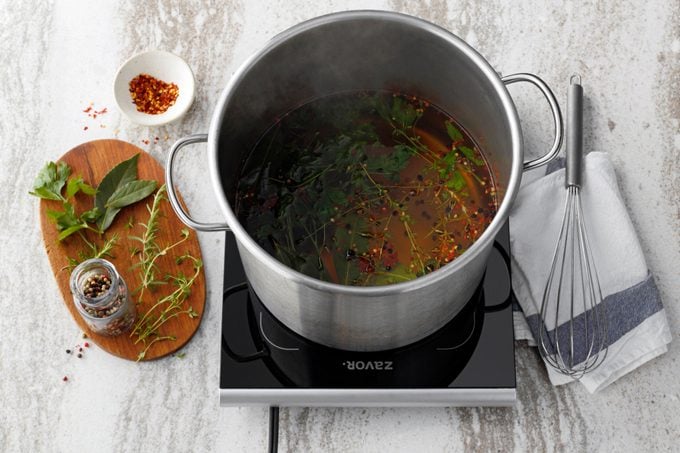
In a large stockpot, create the brine by combining 4 quarts of water with the salt, sugar, parsley, thyme, rosemary, bay leaves, crushed red pepper flakes and whole peppercorns. Bring the mixture to a simmer and cook, stirring occasionally, until the sugar and salt are dissolved. Remove the mixture from the heat and add the additional 4-1/2 quarts of cold water to bring the solution to room temperature.
Editor’s Tip: If you’re running short on time and ingredients, skip the aromatics. These extra ingredients add flavor, but salt is all you really need to produce a tender, juicy turkey.
Step 2: Prepare the turkey for brining
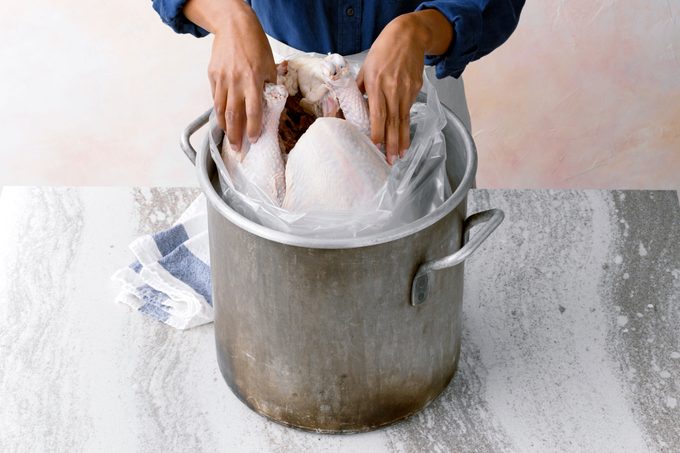
Remove the turkey from the packaging and set aside the neck and giblets for make-ahead turkey gravy. Place the turkey in an oven bag or your brining container.
Step 3: Submerge the turkey in the brine
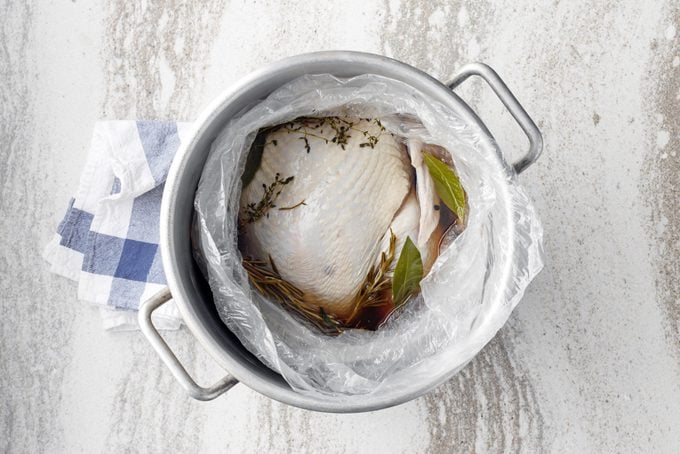
Pour the cooled brine over the turkey, adding additional cold water as needed to ensure the turkey is completely submerged. Weigh the turkey down with a plate or bowl if it floats.
Step 4: Let the turkey brine
Brine the turkey in the refrigerator or an ice-filled cooler for 18 to 24 hours. If you’re brining outside the refrigerator, use a probe thermometer to ensure the brine’s temperature doesn’t exceed 40°F.
Step 5: Remove the turkey from the brine

Remove the turkey from the brine and pat it dry with paper towels. For crispier skin, let the turkey sit in the refrigerator on a roasting rack for an additional 24 hours to dry out the skin.
Step 6: Cook the turkey

Roast, grill or smoke the turkey using your favorite recipe. Check out our complete guide for how to cook a turkey for tips from start to finish, such as how to carve a turkey and more.
Turkey Brine Ideas
A traditional brine only uses salt and water, but you can absolutely add additional ingredients if you wish. Unlike salt—which can permeate into the meat—these ingredients only add skin-deep flavor, but they’re a great way to add a little bit of complexity to your turkey. No matter which ingredients you choose to add to your brine, don’t forget to add them to your Thanksgiving shopping list!
Liquids
Try using flavorful liquids instead of water. Substitute some or all of the water for chicken broth, apple cider, juice or the liquid of your choosing. You can also add some hard alcohol to the brine, too. Alcohol can help carry the brine’s flavors, allowing them to penetrate deeper into the meat. As little as a tablespoon of strong neutral alcohols like vodka or as much as 1/4 cup of flavorful alcohol like rum or gin is all you need. If you’re using a weaker alcohol like wine or beer, feel free to add more.
Looking for a recipe with a flavorful brine? Our apple-brined turkey uses apple juice and brown sugar to add classic fall flavors to your meat.
Aromatics
Fresh herbs, spices, citrus peels, aromatic vegetables (like onions, celery or garlic) or flavorful ingredients like soy sauce or Worcestershire are never a bad idea in a brine, either. Our recipe for herb-brined turkey uses fresh sage, thyme and rosemary to give the turkey some depth.
Sweeteners
Try adding sweet ingredients like sugar, brown sugar, molasses or honey to the mix. These ingredients add sweetness and also promote browning on the skin. Some brine recipes call for both salt and sugar—similar to the salt, sugar helps the osmosis process. Our recipe for honey-brined turkey calls for honey, Dijon mustard and apple cider to create a more complex flavor profile in the meat.
Turkey Brining Tips
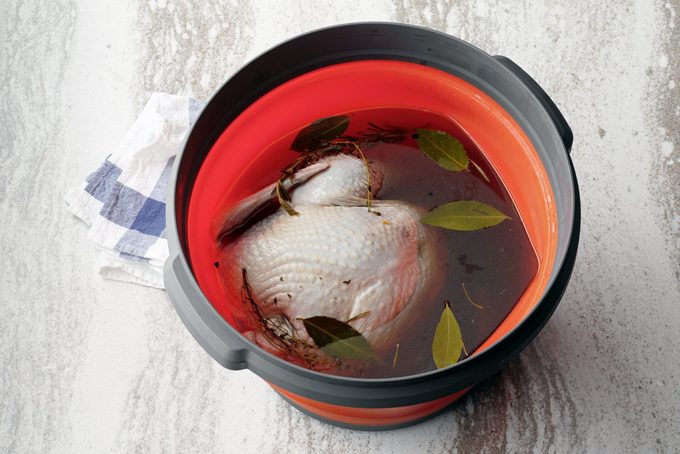
What type of turkey is best for brining?
Make sure you pick up a bird that hasn’t been brined already—otherwise, your meat will turn out too salty. When you’re at the grocery store, avoid turkeys that are labeled as kosher, enhanced or self-basting. Check the ingredients, too: Some turkeys will have additions other than turkey, such as a solution with salt and broth or water—which tips you off that it’s already been brined. Find out if you should wash your turkey.
Can you brine a frozen turkey?
It’s definitely possible to brine and defrost turkey at the same time. Simply remove the turkey from the bag, and drop it into a container with the wet brine. The turkey will act like a block of ice, and the added salt in the brine keeps the water temperature low enough. When brining outside the refrigerator, it’s best to use a probe thermometer to ensure the temperatures never exceed 40°.
For dry brining, you’ll want to start with a turkey that’s at least partially thawed. The skin needs to be thawed enough to rub in the salt. Since there’s no water involved, this method absolutely requires the refrigerator to finish thawing the turkey safely.
Do you season turkey after brining?
Brine is very salt-rich, so there’s no reason to add salt to a brined turkey. You can add your favorite dry rub, herbs or spices to the turkey after it brines, or you can add flavor to the turkey later by serving it with a compound butter.
Do you have to cook the turkey immediately after brining?
If you brined too far in advance, don’t fret: You don’t have to cook your turkey immediately after it brines. In fact, it’s sometimes best to let a wet-brined turkey sit in the refrigerator, uncovered, for an additional 24 hours to let the skin dry out. For storage periods longer than 24 hours, cover the turkey lightly in plastic wrap.
How long should I brine my turkey?
It’s best to brine turkey for 12 to 24 hours. Brining it for longer than 24 hours can result in mushy meat and an overly salty flavor. If you do accidentally over-brine it, you can soak the turkey in cold water to remove some of the excess salt, but it likely won’t have the best flavor or texture.
Should I rinse my turkey after brining?
You won’t need to rinse the turkey after brining if you dry brined using the proper salt ratio (that’s one tablespoon of kosher salt for every two pounds of turkey). Most of the salt will have dissolved into the skin overnight, so just pat the skin dry with paper towels and roast as normal.
For wet brines, we generally don’t rinse when we brine overnight, either. If the turkey sat in the solution for longer than 24 hours, or if you used a brine that’s stronger than our general brine ratio (1/4 cup kosher salt per quart of water), it’s not a bad idea to give it a quick rinse.
That said, if you’re worried about the turkey turning out salty, go ahead and rinse it. It won’t hurt anything! Just be sure to sanitize the sink and surrounding area, as raw poultry comes with a risk for food-borne illness.

